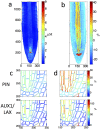A recovery principle provides insight into auxin pattern control in the Arabidopsis root
- PMID: 28220889
- PMCID: PMC5318957
- DOI: 10.1038/srep43004
A recovery principle provides insight into auxin pattern control in the Arabidopsis root
Abstract
Regulated auxin patterning provides a key mechanism for controlling root growth and development. We have developed a data-driven mechanistic model using realistic root geometry and formulated a principle to theoretically investigate quantitative auxin pattern recovery following auxin transport perturbation. This principle reveals that auxin patterning is potentially controlled by multiple combinations of interlinked levels and localisation of influx and efflux carriers. We demonstrate that (1) when efflux carriers maintain polarity but change levels, maintaining the same auxin pattern requires non-uniform and polar distribution of influx carriers; (2) the emergence of the same auxin pattern, from different levels of influx carriers with the same nonpolar localisation, requires simultaneous modulation of efflux carrier level and polarity; and (3) multiple patterns of influx and efflux carriers for maintaining an auxin pattern do not have spatially proportional correlation. This reveals that auxin pattern formation requires coordination between influx and efflux carriers. We further show that the model makes various predictions that can be experimentally validated.
Conflict of interest statement
The authors declare no competing financial interests.
Figures









References
-
- Vanneste S. & Friml J. Auxin: A Trigger for Change in Plant Development. Cell 136, 1005–1016 (2009). - PubMed
-
- Sabatini S. et al.. An auxin-dependent distal organizer of pattern and polarity in the Arabidopsis root. Cell 99, 463–472 (1999). - PubMed
-
- Dubrovsky J. G. et al.. Auxin minimum defines a developmental window for lateral root initiation. New Phytol. 191, 970–983 (2011). - PubMed
-
- Moubayidin L. et al.. The rate of cell differentiation controls the Arabidopsis root meristem growth phase. Curr. Biol. 20, 1138–43 (2010). - PubMed
Publication types
MeSH terms
Substances
Grants and funding
LinkOut - more resources
Full Text Sources
Other Literature Sources

